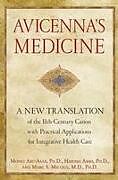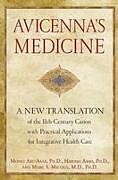Avicenna's Medicine
Einband:
Fester Einband
EAN:
9781594774324
Untertitel:
A New Translation of the 11th-Century Canon with Practical Applications for Integrative Health Care
Genre:
Gesundheit, Ernährung & Wellness
Autor:
Mones Abu-Asab, Hakima Amri, Marc S. Micozzi
Herausgeber:
HEALING ARTS
Anzahl Seiten:
480
Erscheinungsdatum:
04.07.2013
ISBN:
978-1-59477-432-4
ldquo;A book like this is extremely timely. ..It is a brilliant illustration, on a solid scientific basis, of what a traditional medical system can bring to the 21st century medicine and medical debates. It is certainly not an easy read, but one that requires a pen in hand and time to reflect upon the ideas expressed within. This exercise of interpretation is a good introduction to traditional medicine thinking that will be of interest to students, scholars, and the intellectually curious.”
Autorentext
Mones Abu-Asab, Ph.D., is a senior scientist at the National Eye Institute of the National Institutes of Health in Bethesda, Maryland. Hakima Amri, Ph.D., is associate professor of biochemistry and molecular and cellular biology at Georgetown University and cofounder and codirector of Georgetown’s Complementary and Alternative Medicine Graduate Program. Marc S. Micozzi, M.D., Ph.D., is adjunct professor of pharmacology and physiology at Georgetown University School of Medicine and the founding director of the Policy Institute for Integrative Medicine in Washington, D.C.
Klappentext
The first contemporary translation of the 1,000-year-old text at the foundation of modern medicine and biology.
Leseprobe
CHAPTER 10
Symptoms and Signs
Third Lesson of the Second Art: Symptoms and Signs
• Introduction (11 sections)
• First Statement: Pulse (19 sections)
• Second Statement: Urine and Feces (13 sections)
The Third Lesson of the Second Art of Disease, Causes, and General Symptoms is a rich part of the canon addressing the main symptoms and signs of pulse and urine and feces. The nineteen sections of the First Statement address the pulse, its characteristics, irregularity and its types, causes of irregularity, and indicators. They also discuss the pulse of genders, ages, temperaments, seasons, and geographic locations as well as the effect on pulse of food and drink, sleep and wakefulness, exercise, bathing, pain, swellings, and psychological conditions.
FIRST STATEMENT
Pulse
(19 sections)
FIRST SECTION
General Statement on Pulse
We say that pulse is a movement within the vessels of the “spirit” and consists of relaxation and contraction to cool down the “spirit” with air. Examination of pulse is either general or specific according to each disease. Here we will discuss the general rules and postpone the specific to the discussion of particular diseases. A pulse is composed of two movements (systole) and two rests (diastole). It is definite that each successive beat has four parts in this sequence: relaxation, rest, contraction, and rest.
The reasons for examining the pulse in the left forearm are three: easy to access, very little difficulty in detecting it, and straightforward position near the heart. At the time of pulse examination the individual should be free of anger, joy, exertion, and other reactions; should not have overeaten or be hungry; and has not quit long-term habits or acquired new ones. The exam should compare the pulse to that of a person of good equitable temperament.
There are ten types by which the physician determines the state of pulse. These are:
1. amount of expansion
2. strength as a force felt against the finger
3. speed
4. compressibility/elasticity
5. turgor (volume): tension of the fullness
6. temperature of the pulse
7. duration of diastole
8. constancy
9. regularity and irregularity
10. rhythm of the pulse
It should be known that the pulse has a musical nature. Just as musical composition is achieved by tones with a ratio between them in pitch, weight, and rhythm, so is the pulse. Music’s time ratio in tempo and frequency is the rhythm, and the rhythm and pitch can be synchronized or not, and asynchrony may be regular or irregular. Similarly, the ratios of strength and weakness and amount within the pulse may be in synchrony or not.
We say the pulse is either having a good rhythm or abnormal rhythm (dysrhythmia). Abnormal rhythm has three subtypes: overrhythmic (pararhythmic), which manifests as transcending the rhythm of an age group to the following age group, such as a child having the pulse of a young man; variable rhythm (heterorhythmic), such as a boy having the pulse of an old man; and out of rhythm (etrhythmic), which does not resemble the pulse of any age group. A large departure of pulse from rhythm indicates major changes in the body.
THIRD SECTION
Types of Special Compound Pulse
1. Gazelle: It varies in one part. If it is slow, it becomes discontinued, then rapid.
2. Wavy: It is variable in regard to vessels, their width, thinness, height, and breadth. It also varies in being immature or late in starting the beat with some softness. It is not that small and has some breadth. It feels like straight waves following each other with variation in their height, bottom, and speed.
3. Wormy: It is like the wavy except it is smaller with higher frequency, which erroneously imply speed, but it is not fast.
4. Antlike: It is much smaller with higher frequency than the wormy, and they both differ in their height as well as advancement or delay, which are felt by touch and are the only distinguishing features between the two, but not the breadth.
5. Sawlike: It is fast, frequent, solid, and varies in its large breadth as well as hardness and softness.
SIXTEENTH SECTION
Pulse of Pains
Pain affects the pulse either because of its intensity, being in a main organ, or when it lasts for a long time. Initially pain excites the faculty (the heart) and instigates it to resist and defend and ignites the heat; therefore, the pulse is large, fast, and very irregular. When the pain overwhelms the faculty, the pulse starts to turn around and weakens until it loses its largeness and speed. This is followed by high frequency first, then smallness, wormlike and antlike pulses. If the pain becomes worse, it increases irregularity and leads to death.
SEVENTEENTH SECTION
Pulse of Swellings
Some swellings cause fevers, and because of their size or location within a vital organ their fever changes the pulse in the whole body. Other swellings do not induce fever, thus change the pulse of the organ where the swelling is located; it may change it in the whole body indirectly, not as swelling but as a pain. Pulse-changing swelling causes changes according to its type, phase, size, and location within an organ, or by the effects it causes.
Inhalt
Foreword: In Defense of Medical Tradition by Alain Touwaide
Preface
Introduction: Why Revisit a Thousand-Year-Old Book?
1 Concepts of Unani Medicine: A Primer
First Art
Definition of Medicine and Its Topics
2 Topics of Medicine
3 The Unani Elements: The Basics or Origins
4 The Theory of Temperaments
5 The Humors
6 The Organs according to Avicenna
7 A General View of the Faculties and Actions
Second Art
Disease, Causes, and General Symptoms
8 Diseases
9 Causes
10 Symptoms and Signs
Third Art
Health, Disease, and the Necessity of Death
11 Introduction to the Third Art
12 Raising Children
13 Common Regimen of Adults
14 Health Management of the Elderly
15 Management of the Dystempered Body
16 Transitions, Seasonal Management, and Travelers
Fourth Art
Aspects of Treatments according to General Diseases
Epilogue
Arabic-English Glossary of the Canon
…

Leider konnten wir für diesen Artikel keine Preise ermitteln ...
billigbuch.ch sucht jetzt für Sie die besten Angebote ...
Die aktuellen Verkaufspreise von 5 Onlineshops werden in Realtime abgefragt.
Sie können das gewünschte Produkt anschliessend direkt beim Anbieter Ihrer Wahl bestellen.
Loading...
Die aktuellen Verkaufspreise von 5 Onlineshops werden in Realtime abgefragt.
Sie können das gewünschte Produkt anschliessend direkt beim Anbieter Ihrer Wahl bestellen.
| # | Onlineshop | Preis CHF | Versand CHF | Total CHF | ||
|---|---|---|---|---|---|---|
| 1 | Seller | 0.00 | 0.00 | 0.00 |
